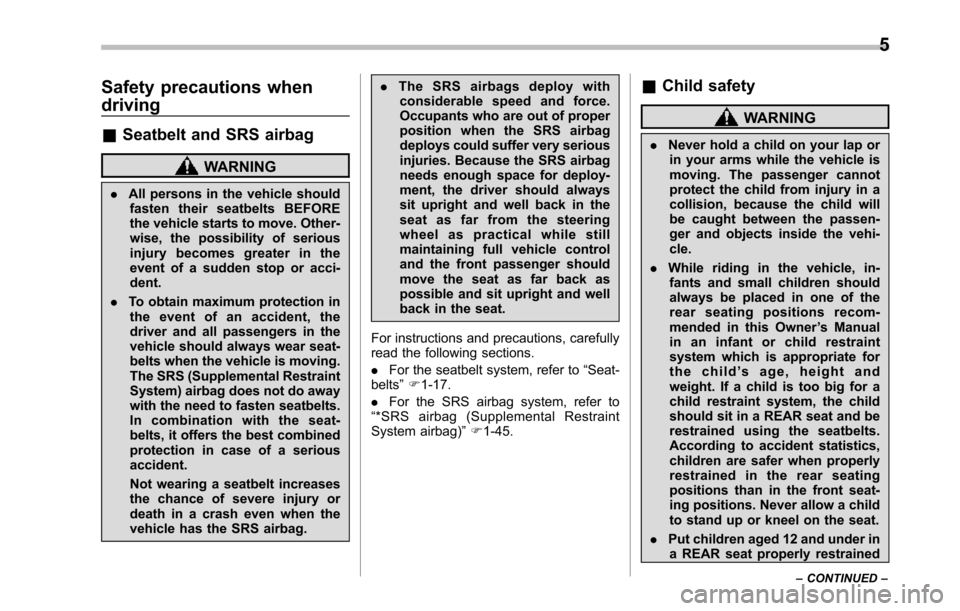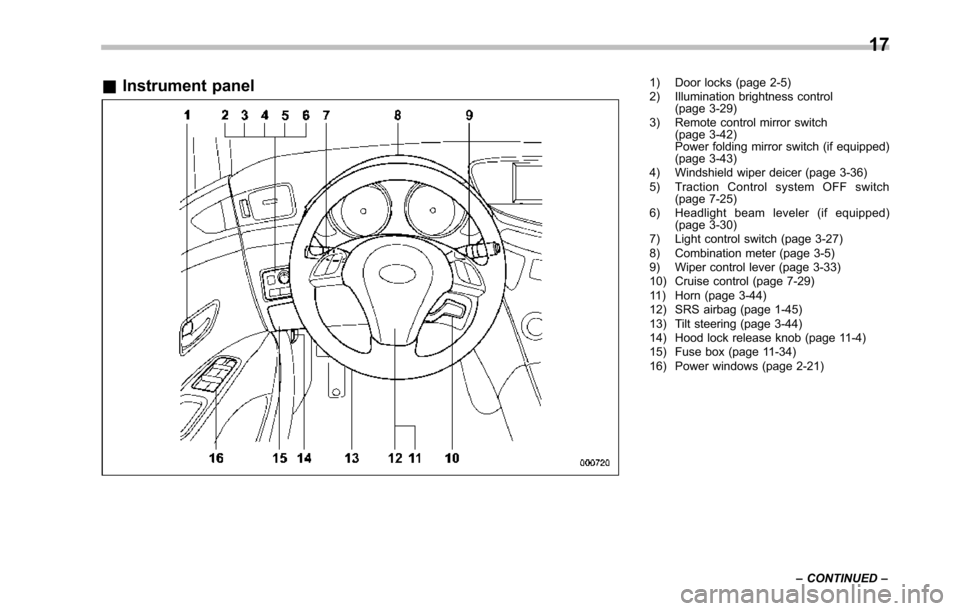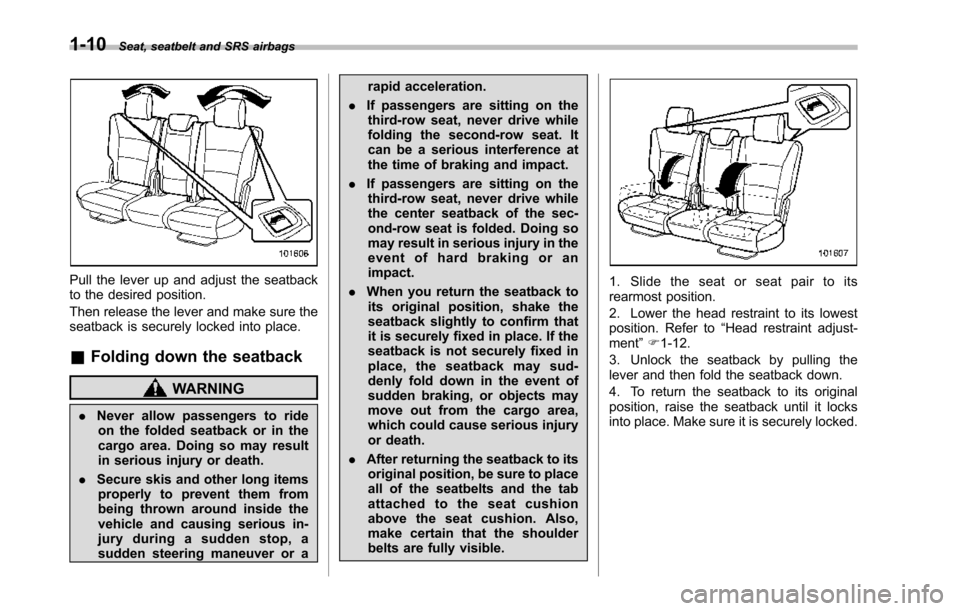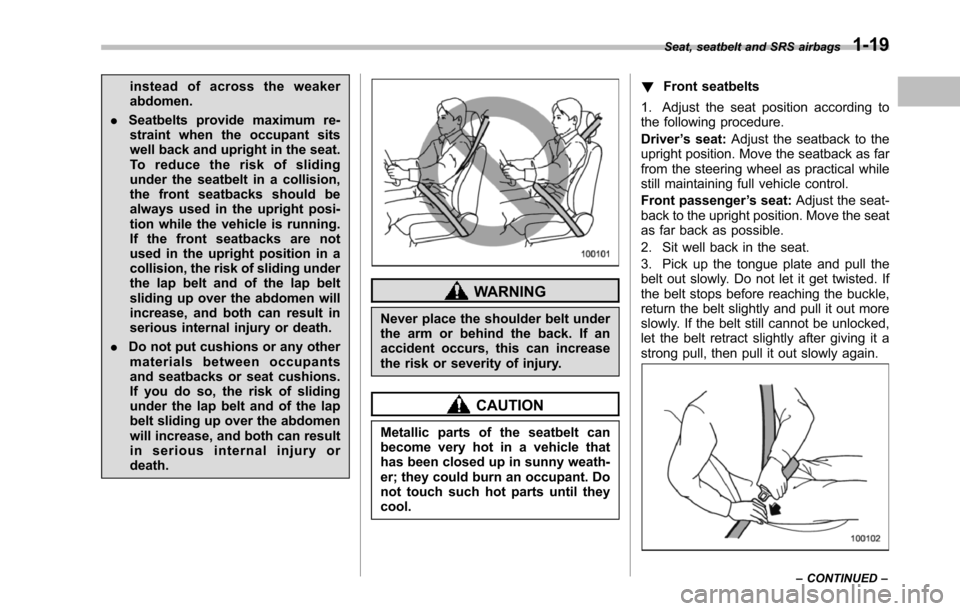2014 SUBARU TRIBECA steering
[x] Cancel search: steeringPage 10 of 426

Safety precautions when
driving
&Seatbelt and SRS airbag
WARNING
.All persons in the vehicle shouldfasten their seatbelts BEFOREthe vehicle starts to move. Other-wise, the possibility of seriousinjury becomes greater in theevent of a sudden stop or acci-dent.
.To obtain maximum protection inthe event of an accident, thedriver and all passengers in thevehicle shouldalways wear seat-belts when the vehicle is moving.The SRS (Supplemental RestraintSystem) airbag does not do awaywith the need to fasten seatbelts.In combination with the seat-belts, it offers the best combinedprotection in case of a seriousaccident.
Not wearing a seatbelt increasesthe chance of severe injury ordeath in a crash even when thevehicle has the SRS airbag.
.The SRS airbags deploy withconsiderable speed and force.Occupants who are out of properposition when the SRS airbagdeploys could suffer very seriousinjuries. Because the SRS airbagneeds enough space for deploy-ment, the driver should alwayssit upright and well back in theseat as far from the steeringwheel as practical while stillmaintaining full vehicle controland the front passenger shouldmove the seat as far back aspossible and sit upright and wellback in the seat.
For instructions and precautions, carefullyread the following sections.
.For the seatbelt system, refer to“Seat-belts”F1-17.
.For the SRS airbag system, refer to“*SRS airbag (Supplemental RestraintSystem airbag)”F1-45.
&Child safety
WARNING
.Never hold a child on your lap orin your arms while the vehicle ismoving. The passenger cannotprotect the child from injury in acollision, because the child willbe caught between the passen-ger and objects inside the vehi-cle.
.While riding in the vehicle, in-fants and small children shouldalways be placed in one of therear seating positions recom-mended in this Owner’s Manualin an infant or child restraintsystem which is appropriate forthe child’sage,heightandweight. If a child is too big for achild restraint system, the childshould sit in a REAR seat and berestrained using the seatbelts.According to accident statistics,children are safer when properlyrestrained in the rear seatingpositions than in the front seat-ing positions. Never allow a childto stand up or kneel on the seat.
.Put childrenaged 12 and under ina REAR seat properly restrained
5
–CONTINUED–
Page 22 of 426

&Instrument panel1) Door locks (page 2-5)2) Illumination brightness control(page 3-29)3) Remote control mirror switch(page 3-42)Power folding mirror switch (if equipped)(page 3-43)4) Windshield wiper deicer (page 3-36)5) Traction Control system OFF switch(page 7-25)6) Headlight beam leveler (if equipped)(page 3-30)7) Light control switch (page 3-27)8) Combination meter (page 3-5)9) Wiper control lever (page 3-33)10) Cruise control (page 7-29)11) Horn (page 3-44)12) SRS airbag (page 1-45)13) Tilt steering (page 3-44)14) Hood lock release knob (page 11-4)15) Fusebox (page 11-34)16) Power windows (page 2-21)
17
–CONTINUED–
Page 33 of 426

1-2Seat, seatbelt and SRS airbags
Front seats
WARNING
.Never adjust the seat while driv-ing to avoid loss of vehicle con-trol and personal injury.
.Before adjustingthe seat, makesure luggage and the hands andfeet of second-row seat passen-gers are clear of the adjustingmechanism.
.Do not put objects under the frontseats. They may interfere withfront seat locking and cause anaccident.
.Seatbelts provide maximum re-straint when the occupant sitswell back and upright in the seat.To r e d u c e t h e r i s k o f s l i d i n gunder the seatbelt in a collision,the front seatbacks should bealways used in the upright posi-tion while the vehicle is running.If the front seatbacks are notused in the upright position in acollision, the risk of sliding underthe lap belt and of the lap beltsliding up over the abdomen willincrease, and both can result inserious internalinjury or death.
.The SRS airbags deploy withconsiderable speed and force.Occupants who are out of properposition when the SRS airbagdeploys could suffer very seriousinjuries. Because the SRS airbagneeds enough space for deploy-ment, the driver should alwayssit upright and well back in theseat as far from the steeringwheel as practical while stillmaintaining full vehicle controland the frontpassenger shouldmove the seat as far back aspossible and sit upright and wellback in the seat.
WARNING
Put children aged 12 and under in arear seat properly restrained at alltimes. The SRS airbag deploys withconsiderable speed and force andcan injure or even kill children,especially if they are 12 years ofage and under and are not re-strained or improperly restrained.Because children are lighter andweaker than adults, their risk ofbeing injured from deployment isgreater. Consequently, we stronglyrecommend that ALL children (in-cluding those in child seats andthose that have outgrown child re-straint devices) sit in a REAR seatproperly restrained at all times in achild restraint device or in a seat-belt, whichever is appropriate forthe child’s age, height and weight.
Always secure ALL types of childrestraint devices (including forwardfacingchild seats) in one of the rearseating positions recommended inthis Owner’s Manual.
NEVER INSTALL A REARWARD FA-CING CHILD SEAT IN THE FRONTSEAT. DOING SO RISKS SERIOUSINJURY OR DEATH TO THE CHILDBY PLACING THE CHILD’S HEAD
Page 41 of 426

1-10Seat, seatbelt and SRS airbags
Pull the lever up and adjust the seatbackto the desired position.
Then release the lever and make sure theseatback is securely locked into place.
&Folding down the seatback
WARNING
.Never allow passengers to rideon the folded seatback or in thecargo area. Doing so may resultin serious injury or death.
.Secure skis and other long itemsproperly to prevent them frombeing thrown around inside thevehicle and causing serious in-jury during a sudden stop, asudden steering maneuver or a
rapid acceleration.
.If passengers are sitting on thethird-row seat, never drive whilefolding the second-row seat. Itcan be a serious interference atthe time of braking and impact.
.If passengers are sitting on thethird-row seat, never drive whilethe center seatback of the sec-ond-rowseat is folded. Doing somay result in serious injury in theevent of hard braking or animpact.
.When you return the seatback toits original position, shake theseatback slightly to confirm thatit is securely fixed in place. If theseatback is not securely fixed inplace, the seatback may sud-denly fold down in the event ofsudden braking, or objects maymove out from the cargo area,which could cause serious injuryor death.
.After returning the seatback to itsoriginal position, be sure to placeall of the seatbelts and the tabattached to the seat cushionabove the seat cushion. Also,make certain that the shoulderbelts are fully visible.
1. Slide the seat or seat pair to itsrearmost position.
2. Lower the head restraint to its lowestposition. Refer to“Head restraint adjust-ment”F1-12.
3. Unlock the seatback by pulling theleverand then fold the seatback down.
4. To return the seatback to its originalposition, raise the seatback until it locksinto place. Make sure it is securely locked.
Page 46 of 426

&Folding down the seatback
WARNING
.Never allow passengers to rideon the folded seatback or in thecargo area. Doing so may resultin serious injury or death.
.Secure skis and other long itemsproperly to prevent them frombeing thrown around inside thevehicleand causing serious in-jury during a sudden stop, asudden steering maneuver or arapid acceleration.
.When you returnthe seatback toits original position, shake theseatback slightly to confirm thatit is securely fixed in place. If theseatback is not securely fixed inplace, the seatback may sud-denly fold down in the event ofsudden braking, or objects maymove out from the cargo area,which could cause serious injuryor death.
.Afterreturning the seatback to itsoriginal position, be sure to placeall of the seatbelts and the tabattached to the seat cushionabove the seat cushion. Also,make certain that the shoulder
belts are fully visible.
1) Lowering strap2) Folding lever
1. Pull the lowering strap to lower thehead restraint.
2. Pull up the folding lever to release theseatback lock, and fold down the seat-back. Refer to“Head restraint adjustment”F1-16.
To r e t u r n t h e s e a t b a c k t o i t s o r i g i n a lposition, raise the seatback until it locksinto place. Make sure it is securely locked.
NOTE
1) Holder
.Before folding or raising the seat-back of the third-row seat, confirm thatthe seatbelt is flat against the sidewallat the lower point and the webbing isattached to the holder..When raising the seatback of thethird-row seat, if the seatbelt catcheson the seatback, hold the belt forwardof the seatback while latching theseatback.
Seat, seatbelt and SRS airbags1-15
–CONTINUED–
Page 50 of 426

instead of across the weakerabdomen.
.Seatbelts provide maximum re-straint when the occupant sitswell back and upright in the seat.To r e d u c e t h e r i s k o f s l i d i n gunder the seatbelt in a collision,thefront seatbacks should bealways used in the upright posi-tion while the vehicle is running.If the front seatbacks are notused in the upright position in acollision, the risk of sliding underthe lap belt and of the lap beltsliding up over the abdomen willincrease, and both can result inserious internal injury or death.
.Do not put cushions or any othermaterials between occupantsand seatbacks or seat cushions.If you do so, the risk of slidingunder the lap belt and of the lapbelt sliding up over the abdomenwill increase, and both can resultin serious internal injury ordeath.
WARNING
Never place the shoulder belt underthe arm or behind the back. If anaccident occurs, this can increasethe risk or severity of injury.
CAUTION
Metallic parts of the seatbelt canbecome very hot in a vehicle thathas been closed up in sunny weath-er; they could burn an occupant. Donot touch such hot parts until theycool.
!Front seatbelts
1. Adjust the seat position according tothe following procedure.
Driver’s seat:Adjust the seatback to theupright position. Move the seatback as farfrom the steering wheel as practical whilestill maintaining full vehicle control.
Front passenger’s seat:Adjust the seat-back to the upright position. Move the seatas far back as possible.
2. Sit well back in the seat.
3. Pick up the tongue plate and pull thebelt out slowly. Do not let it get twisted. Ifthe belt stops before reaching the buckle,return the beltslightly and pull it out moreslowly. If the belt still cannot be unlocked,let the belt retract slightly after giving it astrong pull, then pull it out slowly again.
Seat, seatbelt and SRS airbags1-19
–CONTINUED–
Page 77 of 426

1-46Seat, seatbelt and SRS airbags
refer to“Seatbelts”F1-17.
.Do not sit or lean unnecessarilyclose to the SRS airbag. Becausethe SRS airbag deploys withconsiderable speed–faster thanthe blink of an eye–and force toprotect in high speed collisions,the force of an airbag can injurean occupant whose body is tooclose to SRS airbag.
It is also important to wear yourseatbelt to help avoid injuriesthat can result when the SRSairbag contacts an occupant notin proper position such as onethrown forward during pre-acci-dent braking.
Even when properly positioned,there remainsa possibility thatan occupant may suffer minorinjury such as abrasions andbruises to the face or armsbecause of the SRS airbag de-ployment force.
.The SRS airbags deploy withconsiderable speed and force.Occupants who are out of properposition when the SRS airbagdeploys could suffer very seriousinjuries. Because the SRS airbagneeds enough space for deploy-
ment, the driver should alwayssit upright and well back in theseat as far from the steeringwheel as practical while stillmaintaining full vehicle controland the front passenger shouldmove the seat as far back aspossible and sit upright and wellback in the seat.
.Do not place any objects over ornear the SRS airbag cover orbetween you and the SRS airbag.If the SRS airbag deploys, thoseobjects could interfere with itsproper operation and could bepropelled inside the vehicle andcause injury.
WARNING
.Put children aged 12 and under ina rear seat properly restrained atall times. The SRS airbag de-ploys with considerable speedand force and can injure or evenkill children, especially if they are12 years of age and under andare not restrained or improperlyrestrained. Because children arelighter and weaker than adults,their risk of being injured fromdeployment is greater.
Consequently, we strongly re-commend that ALL children (in-cluding those in child seats andthose that have outgrown childrestraintdevices) sit in a REARseat properly restrained at alltimes in a child restraint deviceor in a seatbelt, whichever isappropriate for the child’s age,height and weight.
Always secure ALL types of childrestraint devices (including for-ward facing child seats) in one ofthe rear seating positions recom-mended in this Owner’s Manual.
According to accident statistics,children are safer when properly
Page 80 of 426

&SUBARU advanced frontal
airbag system
Your vehicle is equipped with a SUBARUadvanced frontal airbag system that com-plies with the new advanced frontal airbagrequirements in the amended FederalMotor Vehicle Safety Standard (FMVSS)No. 208.
The SUBARU advanced frontal airbagsystem automatically determines the de-ployment force of the driver’s SRS frontalairbag at the time of deployment as well aswhether or not to activate the frontpassenger’s SRS frontal airbag and, ifactivated, the deployment force of theSRS frontal airbag at the time of deploy-ment.
Your vehicle has warning labels on thedriver’s and front passenger’s sun visorsbeginning withthe phrase“EVENWITHADVANCED AIR BAGS”and a tagattached to the glove box lid beginningwiththe phrase“Evenwith Advanced AirBags”. Make sure that you carefully readthe instructions on the warning labels andtag.
Always wearyour seatbelt. The SUBARUadvanced frontal airbag system is asupplemental restraint system and mustbe used in combination with a seatbelt. Alloccupants should wear a seatbelt or beseated in an appropriate child restraint
system.
The driver’s SRS frontal airbag is stowedin the center portion of the steering wheel.The front passenger’s SRS frontal airbagis stowed near the top of the dashboardunder an“SRS AIRBAG”mark.
In a moderate to severe frontal collision,the driver’s and front passenger’s SRSfrontal airbagsdeploy and supplement theseatbelts by reducing the impact on thedriver’s and front passenger’s head andchest.
WARNING
NEVER INSTALL A REARWARD FA-CING CHILD SAFETY SEAT IN THEFRONT SEAT. DOING SO RISKSSERIOUS INJURY OR DEATH TO
THE CHILD BY PLACING THECHILD’SHEADTOOCLOSETOTHE SRS AIRBAG.
WARNING
Never allow a child to stand up, or tokneel on the front passenger’s seat.The SRS airbag deploys with con-siderable force and can injure oreven kill the child.
Seat, seatbelt and SRS airbags1-49
–CONTINUED–